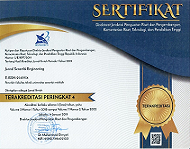Analisis Pengaruh Penambahan Serbuk Sabut Kelapa (Cocopeat) Pada Campuran Agregat Paving Block Terhadap Nilai Daya Serap
Keywords:
cocopeat, paving block, absorption test, sand, constructionAbstract
One of the construction activities in which sand is commonly used is the manufacture of paving blocks, and this is increasing every year as it is used for roads in housing estates, footpaths or paving courtyards. Sand is a fine grain that is physically similar to cocopeat. Cocopeat is a fine powder produced from the destruction of coconut fibre waste. As the physical properties of cocopeat and sand are the same [1], cocopeat has the potential to be used to make paving blocks. The aim of this research is to produce paving blocks with an aggregate mixture of cocopeat, sand, cement, gravel/small stones and water with a composition ratio of cocopeat and sand of 0%, 10%, 25% and 50%. An absorbency test was then carried out on the sample paving blocks and data analysis was carried out to determine the composition of the paving blocks with the best absorbency quality. The research method used was experimental, starting with the collection of materials and the mixing of the composition to make the paving blocks. An absorption test was then carried out on each of the samples produced. The results of this research show that the absorption capacity value obtained from paving blocks with a composition of 0%, 10%, 25% and 50% is 0.07%, 0.28%, 0.66% and 0.55%. On the basis of this absorption capacity value, the paving blocks produced are classified as type A for all compositions in accordance with SNI 03-0691-1996
















